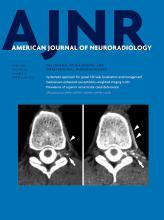Index by author
Lin, X.
- PediatricsOpen AccessMorphologic Evolution and Coordinated Development of the Fetal Lateral Ventricles in the Second and Third TrimestersZ. Li, F. Xu, Z. Zhang, X. Lin, G. Teng, F. Zang and S. LiuAmerican Journal of Neuroradiology April 2019, 40 (4) 718-725; DOI: https://doi.org/10.3174/ajnr.A6013
Littig, I.A.
- EDITOR'S CHOICEAdult BrainOpen AccessGadolinium-Enhanced Susceptibility-Weighted Imaging in Multiple Sclerosis: Optimizing the Recognition of Active Plaques for Different MR Imaging SequencesL.L.F. do Amaral, D.C. Fragoso, R.H. Nunes, I.A. Littig and A.J. da RochaAmerican Journal of Neuroradiology April 2019, 40 (4) 614-619; DOI: https://doi.org/10.3174/ajnr.A5997
The authors analyzed the accuracy of gadolinium SWI for detecting the imaging evidence of active inflammation on MS plaques when a BBB dysfunction was demonstrated by a focal gadolinium-enhanced lesion and compared this technique with gadolinium-enhanced T1 spin-echo and T1 spin-echo with magnetization transfer contrast sequences. Differences in BBB dysfunction were evident in the 103 patients among gadolinium SWI, gadolinium T1 spin-echo, and gadolinium T1 magnetization transfer contrast. Gadolinium T1 magnetization transfer contrast demonstrated the highest number of active demyelinating plaques. Gadolinium SWI was highly correlated with gadolinium T1 magnetization transfer contrast in depicting acute demyelinating plaques and these techniques provided better performance compared with gadolinium T1 spin-echo.
Liu, S.
- PediatricsOpen AccessMorphologic Evolution and Coordinated Development of the Fetal Lateral Ventricles in the Second and Third TrimestersZ. Li, F. Xu, Z. Zhang, X. Lin, G. Teng, F. Zang and S. LiuAmerican Journal of Neuroradiology April 2019, 40 (4) 718-725; DOI: https://doi.org/10.3174/ajnr.A6013
- Adult BrainOpen AccessRisk of Acute Kidney Injury with Consecutive, Multidose Use of Iodinated Contrast in Patients with Acute Ischemic StrokeZ.Y. Jia, S.X. Wang, L.B. Zhao, Y.Z. Cao, H.B. Shi and S. LiuAmerican Journal of Neuroradiology April 2019, 40 (4) 652-654; DOI: https://doi.org/10.3174/ajnr.A5959
Liu, Y.
- EDITOR'S CHOICEAdult BrainOpen AccessMoving Toward a Consensus DSC-MRI Protocol: Validation of a Low–Flip Angle Single-Dose Option as a Reference Standard for Brain TumorsK.M. Schmainda, M.A. Prah, L.S. Hu, C.C. Quarles, N. Semmineh, S.D. Rand, J.M. Connelly, B. Anderies, Y. Zhou, Y. Liu, B. Logan, A. Stokes, G. Baird and J.L. BoxermanAmerican Journal of Neuroradiology April 2019, 40 (4) 626-633; DOI: https://doi.org/10.3174/ajnr.A6015
DSC-MR imaging using preload, intermediate (60°) flip angle and postprocessing leakage correction has gained traction as a standard methodology. Simulations suggest that DSC-MR imaging with flip angle = 30° and no preload yields relative CBV practically equivalent to the reference standard. Eighty-four patients with brain lesions were enrolled in this 3-institution study. Forty-three patients satisfied the inclusion criteria. DSC-MR imaging (3T, single-dose gadobutrol, gradient recalled-echo–EPI, TE=20–35 ms, TR=1.2–1.63 seconds) was performed twice for each patient, with flip angle = 30°–35° and no preload (P-) or provided preload (P+) for an intermediate flipangle = 60°. Compared with 60°/P+/C+, 30°/P-/C+ had closest mean standardized relative CBV, highest Lin concordance correlation coefficient, and lowest Bland-Altman bias.
Logan, B.
- EDITOR'S CHOICEAdult BrainOpen AccessMoving Toward a Consensus DSC-MRI Protocol: Validation of a Low–Flip Angle Single-Dose Option as a Reference Standard for Brain TumorsK.M. Schmainda, M.A. Prah, L.S. Hu, C.C. Quarles, N. Semmineh, S.D. Rand, J.M. Connelly, B. Anderies, Y. Zhou, Y. Liu, B. Logan, A. Stokes, G. Baird and J.L. BoxermanAmerican Journal of Neuroradiology April 2019, 40 (4) 626-633; DOI: https://doi.org/10.3174/ajnr.A6015
DSC-MR imaging using preload, intermediate (60°) flip angle and postprocessing leakage correction has gained traction as a standard methodology. Simulations suggest that DSC-MR imaging with flip angle = 30° and no preload yields relative CBV practically equivalent to the reference standard. Eighty-four patients with brain lesions were enrolled in this 3-institution study. Forty-three patients satisfied the inclusion criteria. DSC-MR imaging (3T, single-dose gadobutrol, gradient recalled-echo–EPI, TE=20–35 ms, TR=1.2–1.63 seconds) was performed twice for each patient, with flip angle = 30°–35° and no preload (P-) or provided preload (P+) for an intermediate flipangle = 60°. Compared with 60°/P+/C+, 30°/P-/C+ had closest mean standardized relative CBV, highest Lin concordance correlation coefficient, and lowest Bland-Altman bias.
Lou, M.
- FELLOWS' JOURNAL CLUBNeurointerventionOpen AccessMetallic Hyperdensity Sign on Noncontrast CT Immediately after Mechanical Thrombectomy Predicts Parenchymal Hemorrhage in Patients with Acute Large-Artery OcclusionC. Xu, Y. Zhou, R. Zhang, Z. Chen, W. Zhong, X. Gong, X. Ding and M. LouAmerican Journal of Neuroradiology April 2019, 40 (4) 661-667; DOI: https://doi.org/10.3174/ajnr.A6008
The authors evaluated 198 consecutive patients with acute ischemic stroke with large-vessel occlusion who underwent noncontrast CT immediately after mechanical thrombectomy between January 2014 and September 2018. The metallic hyperdensity sign was defined as a nonpetechial intracerebral hyperdense lesion in the basal ganglia and a maximum CT density of >90 HU. The metallic hyperdensity sign was found in 59 (29.7%) patients, and 51 (25.7%) patients had parenchymal hemorrhage at 24 hours. Patients with the metallic hyperdensity sign are more likely to have parenchymal hemorrhage than those without it.
Lu, C.-F.
- Adult BrainOpen AccessBehavioral and Structural Effects of Single and Repeat Closed-Head InjuryY.-C.J. Kao, Y.W. Lui, C.-F. Lu, H.-L. Chen, B.-Y. Hsieh and C.-Y. ChenAmerican Journal of Neuroradiology April 2019, 40 (4) 601-608; DOI: https://doi.org/10.3174/ajnr.A6014
Lui, Y.W.
- Adult BrainOpen AccessBehavioral and Structural Effects of Single and Repeat Closed-Head InjuryY.-C.J. Kao, Y.W. Lui, C.-F. Lu, H.-L. Chen, B.-Y. Hsieh and C.-Y. ChenAmerican Journal of Neuroradiology April 2019, 40 (4) 601-608; DOI: https://doi.org/10.3174/ajnr.A6014
Luo, C.-B.
- NeurointerventionYou have accessMorphologic Change of Flow-Related Aneurysms in Brain Arteriovenous Malformations after Stereotactic RadiosurgeryY.-S. Tsuei, C.-B. Luo, L.-Y. Fay, H.-C. Yang, W.-Y. Guo, H.-M. Wu, W.-Y. Chung and M.M.H. TengAmerican Journal of Neuroradiology April 2019, 40 (4) 675-680; DOI: https://doi.org/10.3174/ajnr.A6018
Madaelil, T.P.
- NeurointerventionYou have accessAneurysm Remnants after Flow Diversion: Clinical and Angiographic OutcomesT.P. Madaelil, J.A. Grossberg, B.M. Howard, C.M. Cawley, J. Dion, R.G. Nogueira, D.C. Haussen and F.C. TongAmerican Journal of Neuroradiology April 2019, 40 (4) 694-698; DOI: https://doi.org/10.3174/ajnr.A6010








